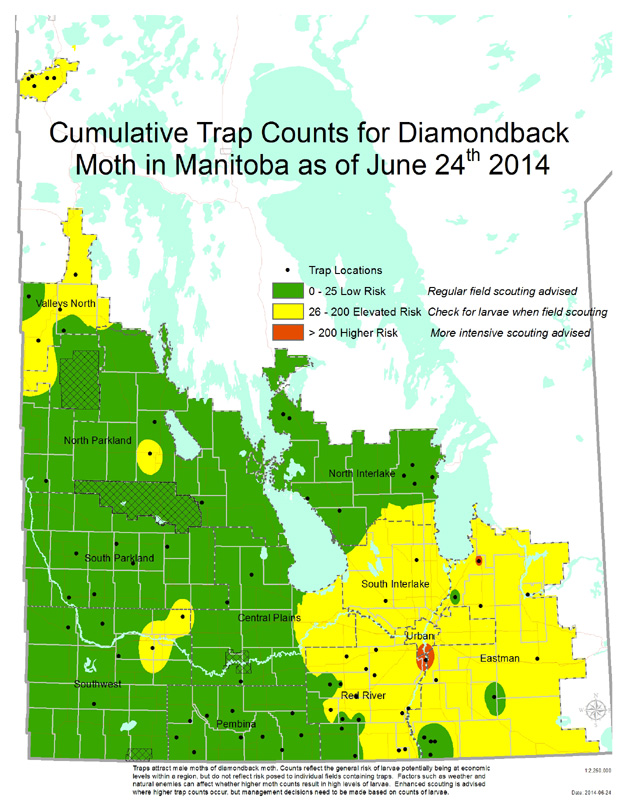Manitoba Insect and Disease Update: June 24, 2014
Compiled by:
- John Gavloski, Entomologist
Manitoba Agriculture, Food and Rural Development
Phone: (204) 745-5668
Fax: (204) 745-5690. - Vikram Bisht, Plant Pathologist
Manitoba Agriculture, Food and Rural Development
Phone: (204) 745-0260
Fax: (204) 745-5690
To report observations on insects or plant pathogens that may be of interest or importance to farmers and agronomists in Manitoba, please send messages to the above contact address.
To be placed on an E-mail list so you will be notified immediately when new Manitoba Insect and Disease Updates are posted, please contact John Gavloski at the address or numbers listed above.
To be placed on an E-mail list so you will be notified immediately when new Manitoba Insect and Disease Updates are posted, please contact John Gavloski at the address or numbers listed above.
Summary
Levels of cutworms remain a concern in some areas, although levels should start declining as some species of cutworms start to pupate. Grasshopper levels are high along field edges in some areas.
Current Scouting Priorities
Insects: Cutworms, grasshoppers, alfalfa weevil in alfalfa.
Pathogens: Time to scout for early incidences of diseases in various crops, especially if the rotation of the crop is frequent or following the same crop. Rhizoctonia root rot in soybean. Tan spot in wheat crop (after wheat in 2013) and FHB risk is high.
Soybeans
Brown spot disease (Septoria) is being observed in young soybean plants in a few fields. With plenty of rains in the last few days, and thunderstorms in some areas, early spots of bacterial leaf blight may be seen. In some fields in Steinbach and Carman, brown spots on lower leaves are being seen. These spots are brown, not showing discoloration on the underside. Preliminary investigation has not revealed any biological cause yet. More work is being done to determine the cause. If you see some spots on soybeans, please send samples or pictures for identification.
Rhizoctonia root rot is also being seen in some fields (Fig. 2). Currently, the plants with Rhizoctonia infection are not showing much above ground symptoms, probably due to sufficient moisture availability in the soil. With drying conditions and heat stress some of these infected plants could show slow growth and lighter color and wilting in severely infected plants
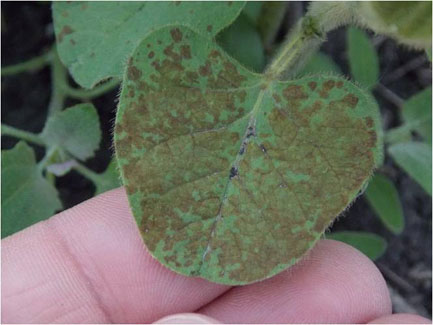
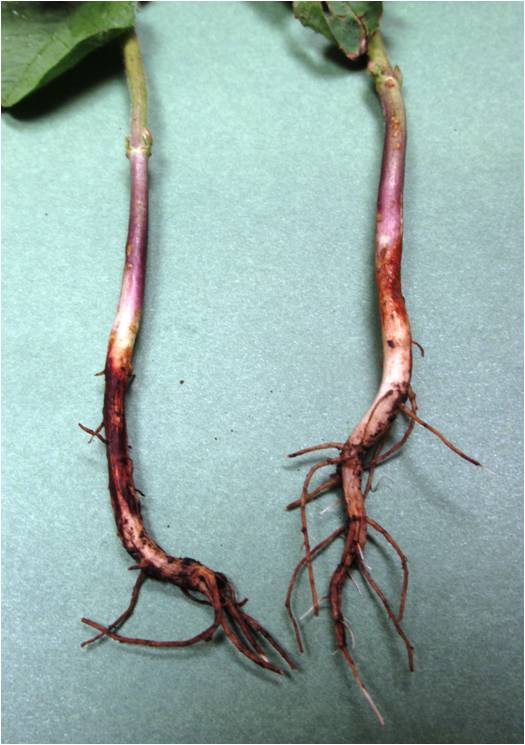
Fig. 1. Soybean leaf spots – yet unknown cause. Fig. 2. Rhizoctonia root rot with reddish-brown discoloration.
Photo courtesy: Earl Bargen, MAFRD Photo courtesy: Vikram Bisht, MAFRD
Wheat
In some fields, where wheat is following wheat, early symptoms of tan spot can be noticed. Tan spots have 3-5mm lens shaped spots, surrounded by yellow chlorosis (Fig. 3). In such fields, under frequent rains, the disease could spread and take hold when the canopy becomes dense. In such cases low rate of fungicide with herbicide application could be considered. But, if the weather turns dry, the disease may not progress much. In good rotations for wheat, early disease risk from crop residue within field is very low and use of fungicide with herbicide may not be of perceptible benefit (other than “peace of mind”).
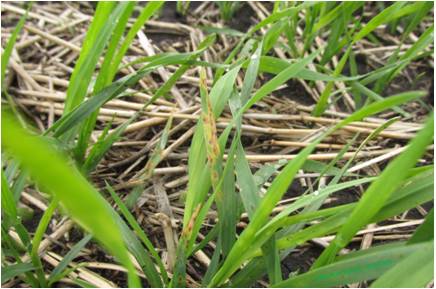
Fig.3. Tan spot disease on young seedlings in wheat after wheat crop.
Photo courtesy: Vikram Bisht, MAFRD
Cutworms
There are still a few reports of high levels of cutworms, although species of our common early-season cutworms, such as redbacked and dingy cutworms, will soon be pupating. As a general guideline, if most of the cutworms are an inch or more long, they will be turning to pupae soon, and except for situations with extremely high levels applying controls will no longer prevent enough damage to be economical.
In a couple of fields, the cutworm species that was found was variegated cutworm (Peridroma saucia). This species is quite different than early-season cutworms such as dingy, redbacked and darksided, which all overwinter here and tend to finish their larval stages by late-June or early-July. Studies in Manitoba found that variegated cutworms can not survive at 0C for 8 weeks or -2C for 4 weeks, and it is assumed that when they occur in Manitoba it is because the moths have blown in. So they do not conform to the pattern of being an early-season concern, with numbers decreasing by late-June. They can be a concern in potatoes where they will feed on tubers underground, and in fruit and vegetable crops where they can get into the fruit. At this point it is hard to say how big the population is, it may be insignificant in most areas. But if you are commonly seeing this species of cutworm, let me know so we can assess what levels are like. For distinguishing features, note the yellow dots, which will be on at least the first 4 abdominal segments, and the 8th abdominal segment has a large black patch on it (Fig. 5).
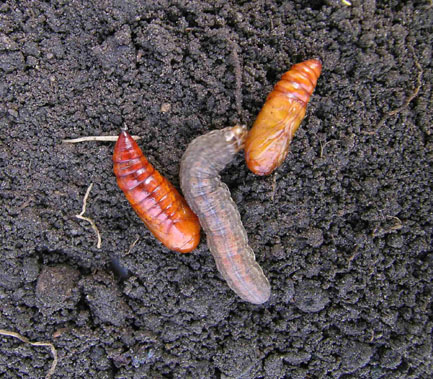
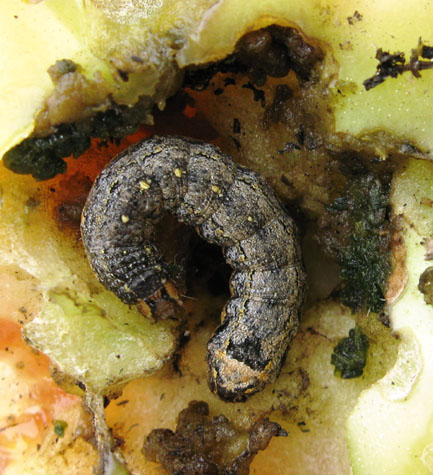
Fig. 4. Redbacked cutworm larva (centre) and pupae Fig. 5. Variegated cutworm
Insect and Disease Monitoring Programs
Fusarium: The Fusarium Head Blight Risk Forecast webpage is now up and running at Province of Manitoba | agriculture - Fusarium Head Blight Report (gov.mb.ca). Frequent and scattered rains throughout the province, in the last few days, would have helped release of Fusarium spores into the air from infected crop residue. If the winter wheat crops are heading or just started flowering in your fields, fungicide application should be considered, since the FHB risk is generally high to extremely high (Fig 6). Rain or dew in the morning create favourable conditions, and can keep the florets prone to infection.

Fig. 6. Risk of FHB is high to extremely high for winter wheat close to or already heading. Map courtesy: Mike Wroblewski, MAFRD.
Diamondback Moth: Trapping of adult moths, using pheromone-baited traps, is now completed. Highest cumulative trap counts are:
| Location | Count |
|---|---|
| St. Adolphe | 287 |
| Stead | 207 |
| Morris 2 | 182 |
| Elm Creek | 136 |
| Morris 1 | 132 |
| The Pas | 105 |
| Teulon | 100 |
Farmers and agronomists should now be looking for larvae of diamondback moth while scouting canola fields, with more intensive monitoring for larvae in areas that had higher trap counts. The final map of the diamondback moth counts is shown below, and the map and seasonal summary can be found at: http://www.gov.mb.ca/agriculture/crops/insects/diamondback-moth-monitoring.html
